Theorising More-Than Human Collectives for Climate Change Action in Museums
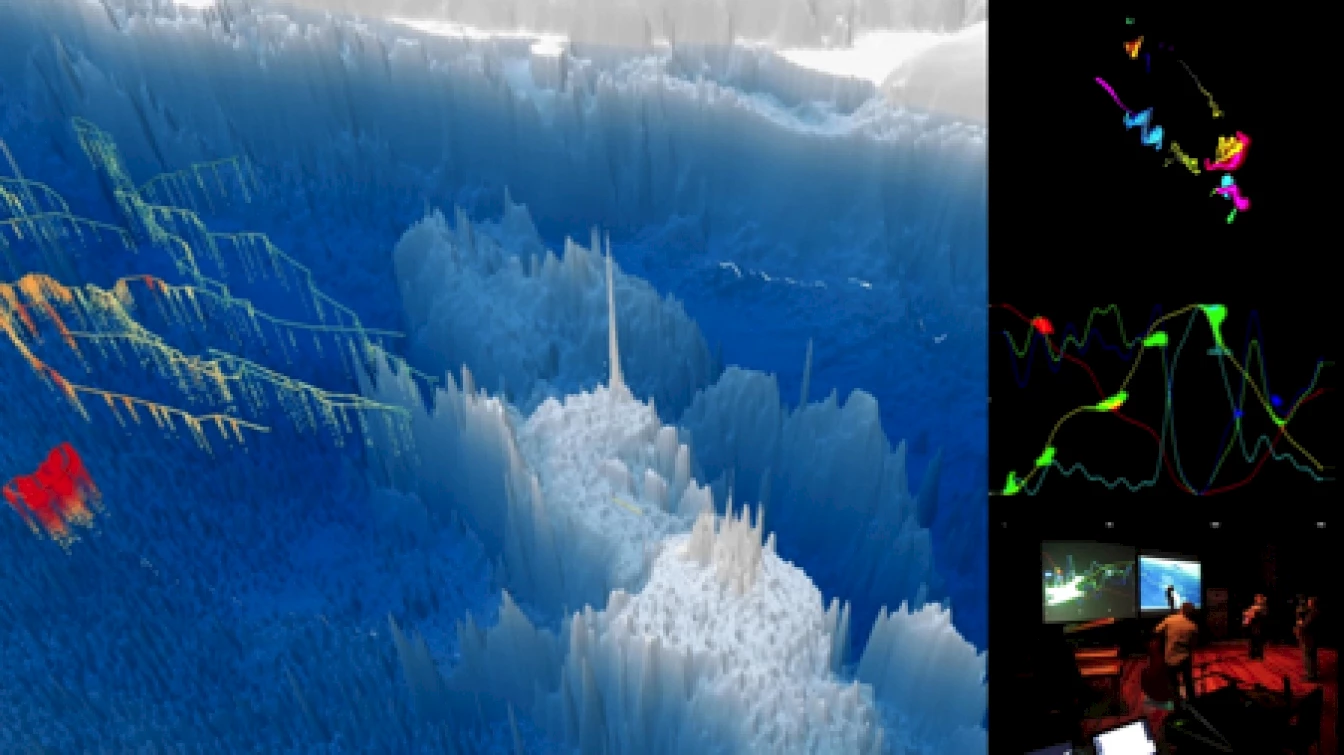
Nigel Helyer and Mary-Anne Lea, Under the Ice Cap, 2012.
Urgent action is required to produce knowledge and cognitive frames that will give rise to new ways of thinking and acting to promote a liveable planet for the long term. Such action requires innovation across all disciplines and sectors. It also demands we engage afresh with familiar established concepts and constructions.
Museums are among modernity's most emblematic and trusted pedagogical institutions. Recognised as icons of modern and critical humanism, they are instrumental in shaping visions of the world, of culture and cultural difference, human relations with the non-human world, technology and science. While recent social constructivist ways of thinking acknowledge reality as socially constructed (Alvesson & Sköldberg 2010) and while the representation of plural subjectivities have become popular, many institutions continue to support the notion of a human-centred world, a separate "given" nature and constructed culture, and binary subject positions.
Modern Dualisms and Museum Practices
In London, The British Museum and Natural History Museum were established in 1753 at a formative point in the development of the natural and human sciences (Foucault 1970) when nature and culture became organised into distinct, independent realms, and the modern humanist Human subject/ object distinction and a reliance on vision set up new relations with the world. The Natural History Museum is an example of the ongoing operation of these doxas. References to "Nature's treasure house" present the museum as an inventory of nature, as a domain separate from humans (Thackray & Press 2013). Exhibitions are devoid of humans except in respect to biological evolutionary relations with other primates. At the Darwin Centre, the museum's collections and research facility, the human subject and object dualism continues to operate where specimens are collected, studied by curators, classified according to their physical attributes and presented as objective facts (Hooper-Greenhill 1992). At the Science Museum in London, the exhibition Atmosphere: Exploring climate change which opened in 2010 presents the atmosphere as an object for human intervention rather than as an entangled socio-biophysical system (Cameron 2014). Even more recent attempts to theorise museums by the "new museology"1 uphold the assumption that human societies are naturally divided into a limited number of non-interacting cultural categories defined according to the "self and other" dualism, and where difference is reduced to a disparity of world views.
According to Mike Hulme, art museums and artists have an important role to play in representing climate change. Yet in the past they have done so without necessarily overcoming dualism. Hulme proposes that institutions and artists work with "the idea of climate change – the matrix of ideological functions, power relations, cultural discourses and material flows that climate change reveals as both a magnifying glass and as a mirror" (Hulme 2009, pp. 362–63). The use of artworks in art museum contexts to explore ecological or environmental concerns has a long history (Payne 2014, p. 159). For example, the exhibition Radical Nature: Art and Architecture for a Changing Planet at the Barbican in London in 2009 served as a retrospective exhibition detailing multifarious ways in which ecology and the environment have been explored in art from 1969 to 2009. The predominant mode of engagement with ecological problems is one of a "restorationist eco-aesthetics" where the focus is on awareness raising and the rescue and repair of damaged ecosystems. Despite good intentions, artworks can still continue to promote the separation between nature and culture, where nature is represented as detached from "social, political or technological processes" as T.J. Demos commented on the 1992 exhibition Fragile Ecologies at Queens Museum of Art in New York (Payne 2014, p. 160).
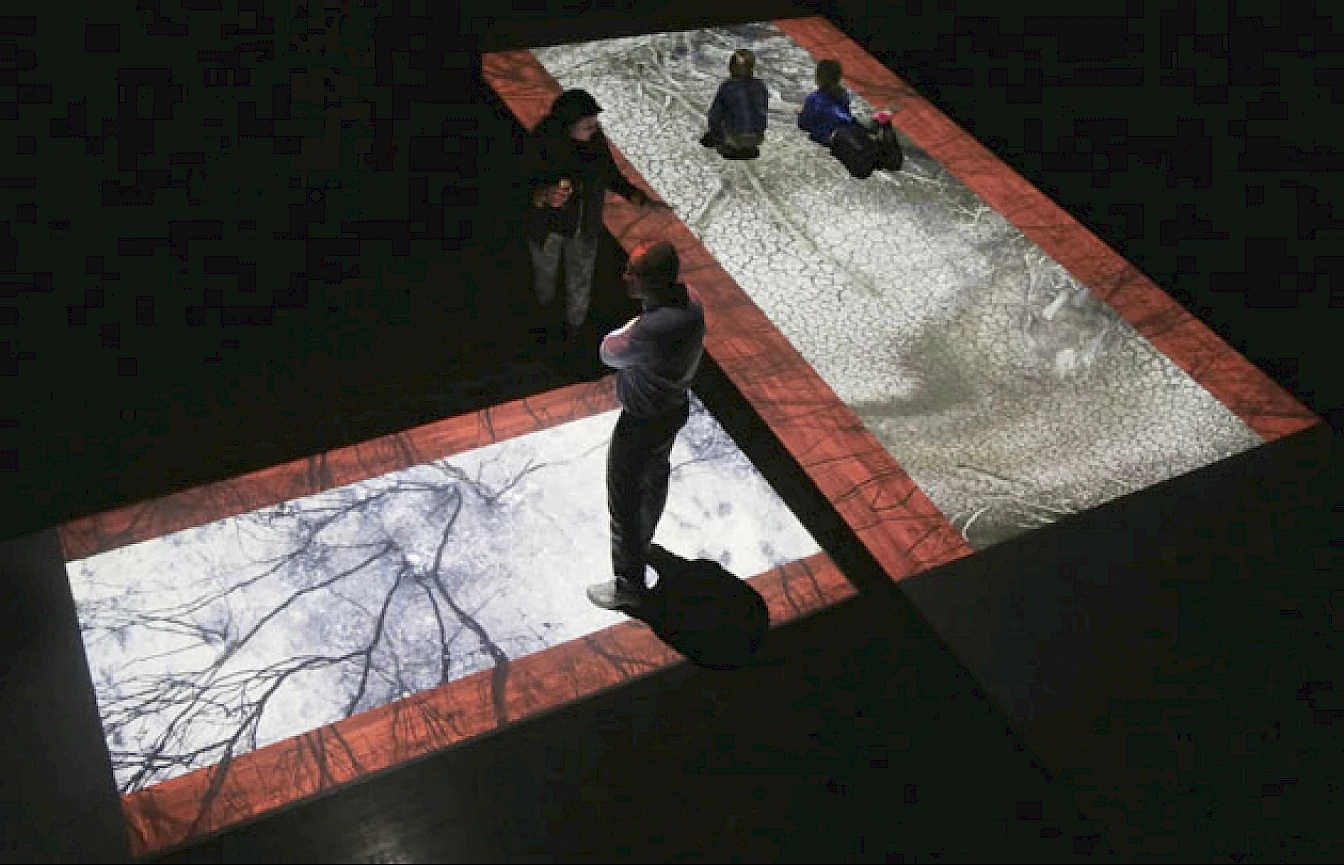
Josephine Starrs and Leon Cmielewski, Augmented Terrain, prototype installation, 2014.
In order to promote viable futures, museums and artists can contribute to the critique of modern ways of thinking and acting by re-working familiar, modernist dualisms such as "nature" and "culture," "human" and "nonhuman," "social" and "natural" "subject" and "object", "self and other" and "real" and "virtual". Thus they have the opportunity to promote new ways to represent, talk about humans, non-humans, culture and cultural diversity, heritage objects, the environment and climate change as alternative narratives, sets of practices and concepts. This can be used purposely to promote a new ethics of care that might better encourage respect for various forms of animate and inanimate things; nourish new forms of interspecies connections, intercultural relations; social inclusiveness and interaction, and that can regard humanity as part of a larger dynamic living system (Domanska 2010).
Modernising and Ecologising
New knowledge practices are emerging in the humanities and social sciences aimed at comprehending and formulating culturally-intelligent ways to re-work modern humanism, dualistic ways of thinking and anthropocentric social collectives, in ways that are better able to deal with real-world complexities, and the climate crisis. This shift represents a move from modern epistemology that sought to discover and represent the empirical world through rational investigation according to a predetermined set of rules to ontology, a practice that seeks to address more directly the composition of the world (Woolgar & Lezaun 2013). These new ontologies claim that all things human and non-human are relationally-connected as part of one dynamic system (Deleuze & Guattari 1987; deLanda 2006; Barad 2007; Bennett 2010; Morton 2010; Latour 1993; Haraway 2007; Harvey 2007; Hodder 2012). There is a growing acceptance of the differences that exist between Indigenous ontologies and the modern paradigm, and the value of the former in informing new approaches to understanding the entangled relationships between the natural world and humans (Harvey 2007) for new types of environmental work.
Theoretical Coordinates for Ecologising Museum Practices
Museum scholars, professionals and artists can progress real-world and scholarly change by undertaking what I call a series of "ecologising experimentations" that have the potential to re-work the possible relations between things and people via new types of museum practices and ways to conceptualise artworks.
The theoretical coordinates I draw upon for framing these "ecologising experimentations" are derived from anthropologist Bruno Latour's (1993; 1998; 2013) notion of "ecologise." For Bruno Latour (1998, p. 22), "ecologising", as opposed to our preoccupation with "modernising", is a political project that seeks to inform new notions of the social by specifying that natural and social entities are bound together in complex interrelations, and that relational and ecological principles bear on every type of connection. While this creates the necessary procedures that make it possible to follow a network of quasi objects (hybrid human and non-human things), I seek to broaden the term to include other proposals that take account of complexity and introduce post-human and non-Western perspectives. Philippe Descola (2013, p. 92) suggests that in order to build a world across modern dualisms we need to first envisage the modern mindset and its idea of the human and the social from the point of view of the relations that hold it together. Latour's (2010) idea of composition is referenced as a way to think about how we might compose or arrange different museum worlds, with respect to the many alternative ways we can entangle ourselves with places, non-humans, technologies, and the material world.
The application of ecologising principles to museum practices and narratives has the potential to dissolve dualistic, hierarchical and imperialistic humanisms. It also breaks the idea of the existence of one-world ontologies and knowledge practices; the privileging of human intentionality as well as time and change as knowable, linear and progressive.
Finally, ecologising museum concepts and practices can break the stranglehold of modern and critical humanisms. This approach acts as a lever to consider how we might connect entities in collectives; formulate inter-relations between human and human and non-humans; found new formulations of history and change; propose new concepts for objects and collections including those defined as virtual and how multiple world views might exist and interact. My objective is to set up new forms of more-than human civic life that have the potential to be made manifest in museum practices and narratives that invite non-human others into social collectives, acknowledges, and is more respectful of, the diversity of forms and modes of thought and ontological categories.
Ecologising experimentations on natural history collections and exhibition narratives have the potential most broadly to re-work human-focused and hubristic perceptions of the world; build new social collectives that can acknowledge and work with the inter-and complementary relations between humans and non-humans; and promote concepts of social inclusiveness and an ethics of care for beyond the human world (Descola 2013, p. 11; Harvey 2007) as a new position from which interspecies transactions can be made. For instance, in Nigel Helyer and Mary-Anne Lea's interlude Under the Ice Cap, complex bio-logging data sets gathered from Southern elephant seals on their Antarctic under-ice dives and ocean transits were combined with economic and climatic data to produce music and sound sculptures. This is a direct response to the fact that these data sets and maps are a means to encode the structures of the Southern Ocean.
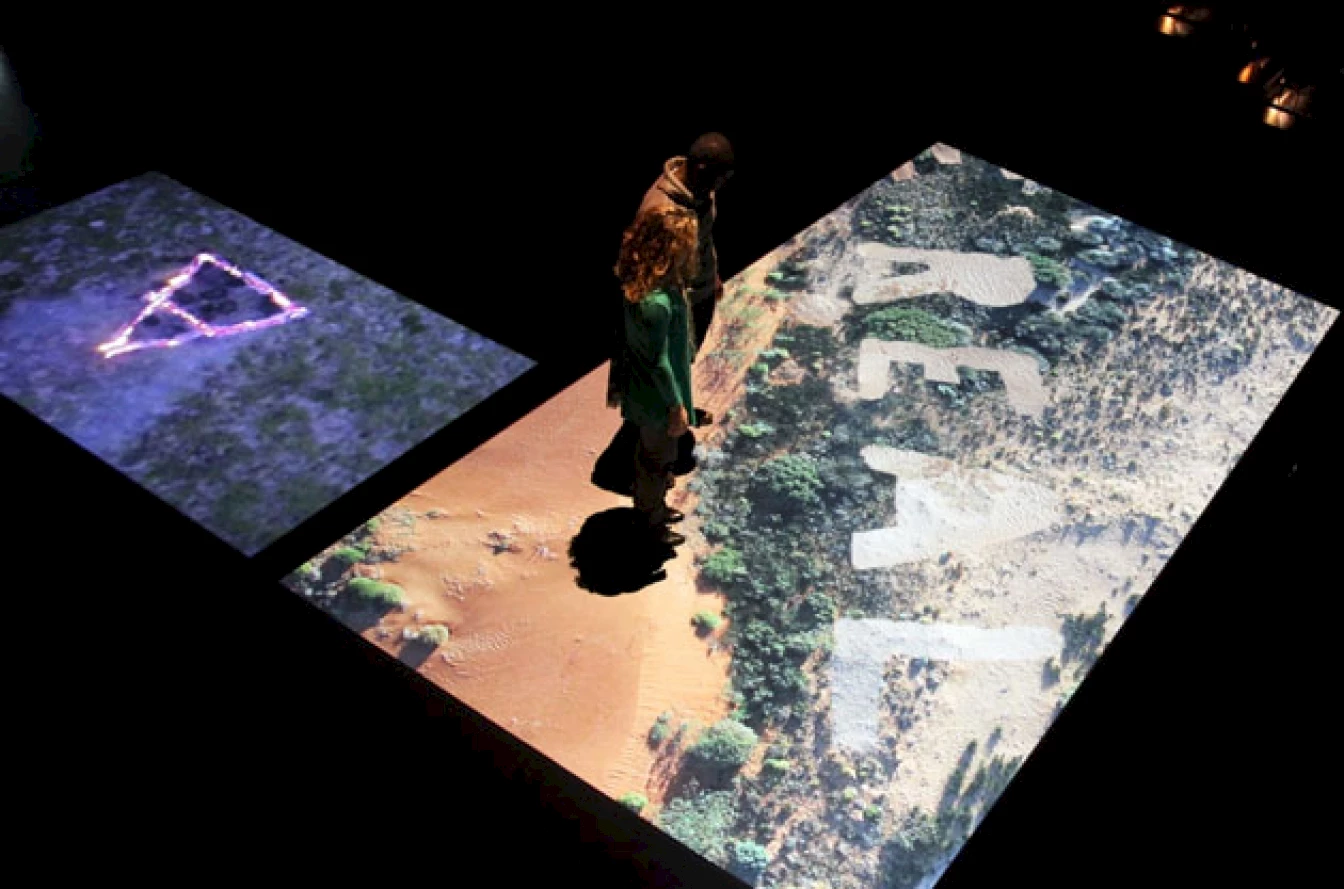
Josephine Starrs and Leon Cmielewski, Augmented Terrain, prototype installation, 2014.
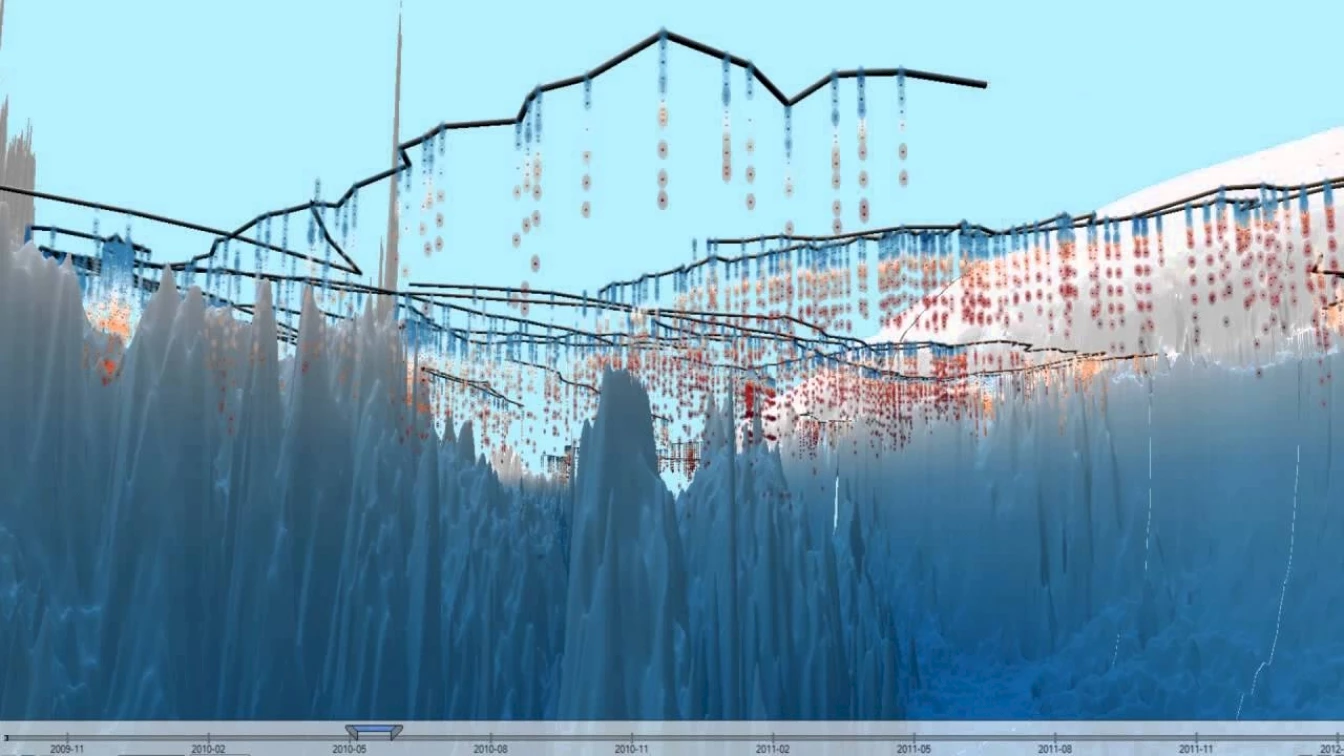
Nigel Helyer and Mary-Anne Lea, Under the Ice Cap, 2012.
Ecologising climate change and environment experimentations can be used to direct us to ways we might break modern human-centred views on climate change and the environment; gesture towards ways we might collapse and individuate modern nature into an array of coordinates some of whom were previously invisible; re-work relations between things as natural-cultural hybrids and fold the human and non-human into dynamic, non-linear and complex systems (Cameron 2014a,b). Augmented Terrain (2014), the large scale media artwork created by Australian artists Josephine Starrs and Leon Cmielewski,2 a collaboration between scientists and artists on the topic of climate change, collapses the "great divide" between nature and culture. Utilising dynamic, spatial visualisations of Australian landscapes and waterways in crisis, the human audience becomes immersed within the landscape where the land itself is conceptualised as active, able to speak and make comment about human impacts. Thus linear notions of cause and effect inherent in mitigation and stabilisation narratives can be re-worked as non-linear complex systems involving the actions and agencies of many human, non-human, technological actors and earthly processes (Cameron 2014b).
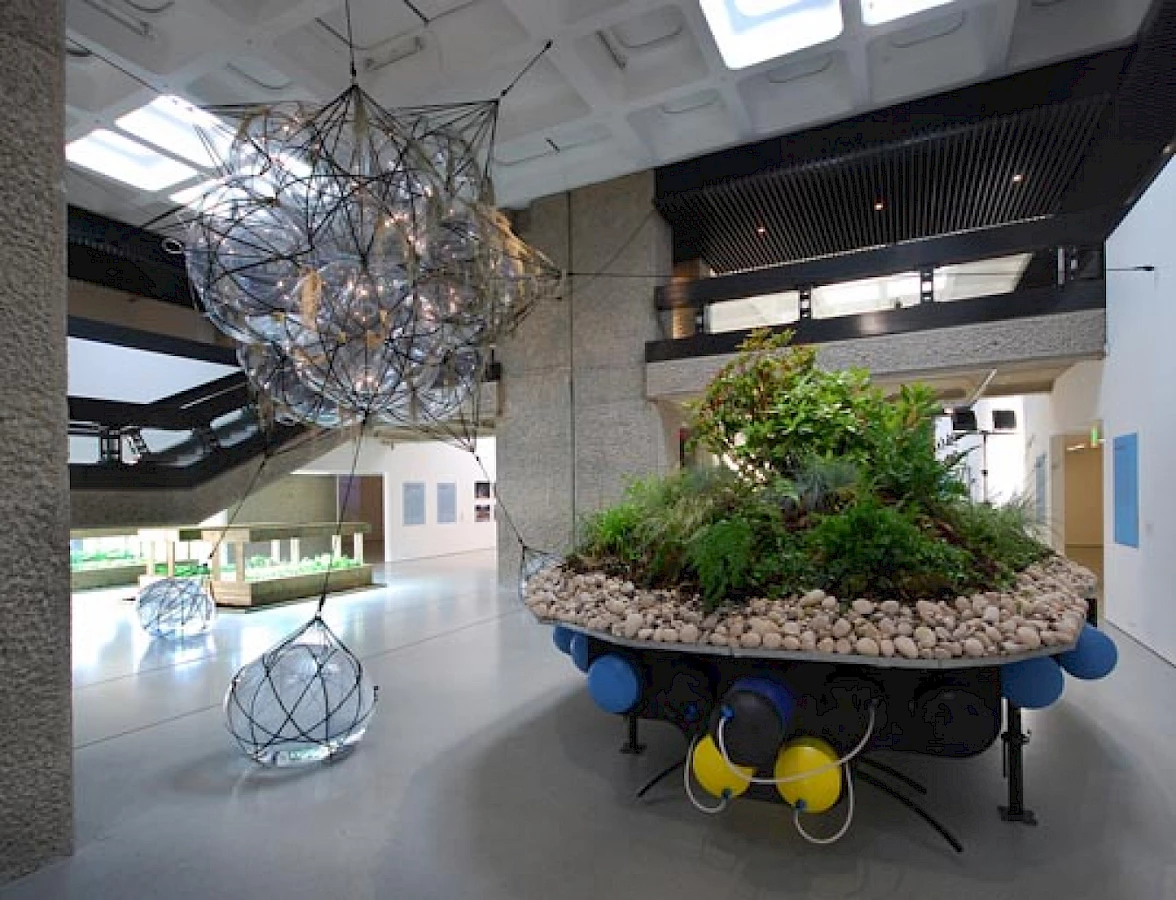
Radical Nature: Art and Architecture for a Changing Planet 1969–2009, installation view, Barbican Art Gallery, 19 June – 18 October 2009. Photo: Lyndon Douglas.
Ecologising work in respect to Human subject/object distinctions in collecting and documentation can be used to formulate new concepts for material culture, artworks and the digital as heterogeneous, socio-material assemblages (Cameron 2010, 2014; Cameron & Kenderdine 2016); re-work objects and artworks as vibrant as opposed to static objective things (Bennett 2010) and as part of more diverse, dynamic social collectives and extended networks (Hodder 2013). Rather than seeing cultural diversity in collections records and narratives of community as plural, cultural expressions set against the backdrop of one world-view and one nature, multi-naturalism (Viveiros de Castro 2005) can be used to re-work cultural diversity as a diversity of natures and a diversity of entities that include non-human others, thus breaking the Culture/ nature and Self/ other division. Ecologising principles can also be directed towards the revision of one-world ontologies and replace them with concepts that allow institutional staff to compose multiple, divergent worlds (Stengers 2005, 994, Latour 2004b; Law 2012), to negotiate different realities and co-produce shared worlds through documentation practices and exhibition narratives between different groups within the museum. Such ecologising experimentations can thereby provide an empirical and theoretical case to support the argument that museum projects can, through the recognition of more-than human social collectives, and the blending of different ontologies, together make an important contribution to producing knowledge that can promote long-term sustainability discourses and strategies for action.
References:
Alvesson, M. and Sköldberg J. 2010, Reflexive Methodology: New Vistas for Qualitative Research, Sage.
Barad, K. 2007, Meeting the Universe Halfway: Quantum Physics and the Entanglement of Matter and Meaning, Duke University Press, Durham, NC.
Bennett, J. 2010, Vibrant Matter: A Political Ecology of Things, Duke University Press, Durham, NC.
Bennett, T. 2009, "Museum, Field, Colony: Colonial Governmentality and the Circulation of Reference", Journal of Cultural Economy, vol. 2, no. 1–2, pp. 99–116.
Cameron, DF. 1972, "The Museum, a Temple or a Forum", Curator, vol. 4, no. 1, pp. 11–24.
Cameron, FR. and Kenderdine, S. 2016, Compositions, materialities, embodiments: theorizing digital cultural heritage for an entangled world, MIT Press, Cambridge, MA (contracted).
Cameron, FR. and Mengler, S. 2015, "Transvisuality, Geopolitics, the Museum and the Death of the Virtual Terrorist", in A. Michelsen, F. Wiegand and T. Kristensen (eds.), Transvisuality: Dimensioning the Visual, Liverpool University Press, Liverpool, pp. 59–72.
Cameron, FR. 2007, "Beyond the Cult of the Replicant, Museums, Objects – New Discourses – Traditional Concerns" in FR. Cameron and S. Kenderdine (eds.), Theorizing Digital Cultural Heritage: a Critical Discourse, MIT Press, Cambridge, MA, pp. 49–77.
Cameron, FR. 2010, "Liquid governmentalities, Liquid Museums and the Climate Crisis." in FR. Cameron and L. Kelly (eds.), Hot Topics, Public Culture, Museums, Cambridge Scholars, Newcastle upon Tyne, pp. 112–128.
Cameron, FR. 2012, "Climate change, Agencies, and the Museum for a complex world", Museum Management and Curatorship, October, vol. 27, no. 4, pp. 317–339.
Cameron, FR. 2014a, "Ecologizing Experimentations: A Method and Manifesto for Museums and Science Centres", in FR. Cameron and B. Neilson (eds.), Climate Change, Museum Futures, Routledge Museum Research series, New York, pp. 16–33.
Cameron, FR. 2014b, "We are on Nature's Side? Experimental Work in Re-writing Narratives of Climate Change for Museum Exhibitions" in Fiona R. Cameron and Brett Neilson (eds.), Climate Change, Museum Futures, Routledge Museum Research series, New York, pp. 51–77.
Cameron, FR. 2015, "The Liquid Museum: New Ontologies for a Climate Changed World" in A. Witcomb and K. Message, Museum Theory: An Expanded Field, Blackwell, UK, pp. 345–362.
deLanda, M. 2006, A New Philosophy of Society: Assemblage Theory and Social Complexity, Continuum, London.
Deleuze, G. and Guattari, F. 1987, A Thousand Plateaus, University of Minnesota Press, Minneapolis.
Descola, P. 2013, Beyond Nature and Culture, University of Chicago Press, Chicago.
Domanska, E. 2010, "Beyond Anthropocentrism", Historical Studies. Historein, vol. 10, pp. 118–130.
Foucault, M. 1970, The Order of Things: An Archaeology of the Human Sciences, Pantheon, New York.
Gosden, C. and Larson, F. 2007, Knowing Things: Exploring the Collections at the Pitt Rivers Museum 1884–1945, Oxford University Press, Oxford.
Haraway, D. 2007, When Species Meet, University of Minnesota Press, Minnesota.
Harrison, R. 2013, Heritage: Critical Approaches, Routledge, Abington and New York.
Harvey, G. 2007, Animism: Respecting the Living World, Columbia University Press New York.
Henning, M. 2006, "New Media", in S. Macdonald (ed.), A Companion to Museum Studies, Blackwell, Oxford, pp. 302–318.
Hodder, I. 2012, Entangled: An Archaeology of the Relationships between Humans and Things, Wiley-Blackwell, Malden, MA.
Hooper-Greenhill, E. 1991, Museums and the Shaping of Knowledge, Routledge, London and New York.
Hulme, M. 2009, Why We Disagree About Climate Change: Understanding Controversy, Inaction and Opportunity, Cambridge University Press, Cambridge.
Janes, R. 2009, Museums in a Troubled World: Renewal, Irrelevance or Collapse?, Routledge, London.
Kenderdine, S. 2013a, Place-Hampi: Inhabiting the Panoramic Imaginary of Vijayanagara, Kehrer Verlag, Heidelberg.
Kenderdine, S. 2013b, "Pure Land: Inhabiting the Mogao Caves at Dunhuang", Curator: The Museum Journal, vol. 56/2, pp. 199–218.
Latour, B. 1993, We Have Never Been Modern, trans. C. Porter, Harvester Wheatsheaf, Hertfordshire.
Latour, B. 1998, "To Modernise or Ecologize? That's the Question", in N. Castree and B. Willems-Braun (eds.), Remaking Reality: Nature at the Millennium, Routledge, London and New York, pp. 221–242.
Latour, B. 2010, "An Attempt at a Compositionist Manifesto", New Literary History, vol. 41, pp. 471–490.
Latour, B. 2013, An Inquiry Into Modes of Existence, Harvard University Press Cambridge, MA.
Linneaus, C. (1735/ 1914), Systema Natura, Nieuwkoop and De Graaf, Amsterdam.
Morton, T. 2010, The Ecological Thought, Harvard University Press, Cambridge, MA and London.
Payne, K. 2014, "Portraying the Political: Contemporary Art Exhibitions and Their Engagement with Climate Change Politics" in FR. Cameron and B. Neilson (eds.), Climate Change, Museum Futures, Routledge Museum Research series, New York, pp. 157–174.
Thackray, J. and Press, B. 2013, Nature's Treasure House: A History of the Natural History Museum, Natural History Museum, London.
Woolgar, S. and Lezaun, J. 2013, "The Wrong Bin Bag: A Turn to Ontology", Social Studies of Science, June, vol. 43, pp. 321–340.
Vergo, P. (ed.) 1989, The New Museology, Reaktion Books, London.
Viveiros de Castro, E. 2005, "Perspective and Multi-naturalism in Indigenous America", in A. Surrallés and P. García Hierro (eds.), The Land Within: Indigenous Territory and the Perception of the Environment, IWGIA, Copenhagen, pp. 36–75.